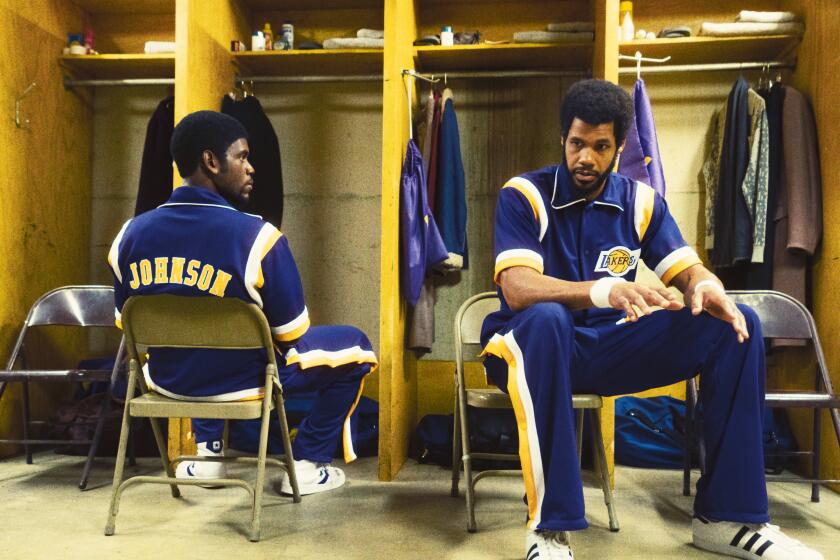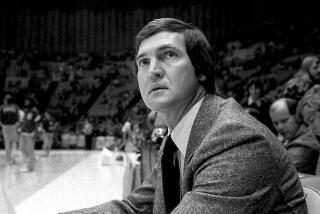- Share via
All good things must come to an end. Including basketball dynasties (and podcast seasons).
In the season finale of “Binge Sesh,” hosts Matt Brennan and Kareem Maddox examine the lasting effects of the Showtime-era Lakers by looking at what came after. From David Stern and the Olympics Dream Team to ESPN and the Chicago Bulls, we discuss how the NBA attained a new level of prominence in the 1990s and explain how the team of the 1980s made it possible.
Listen now
Matt Brennan: OK. So you’ve seen “The Last Dance,” right?
Kareem Maddox: Of course I’ve seen “The Last Dance,” Matt.
Brennan: I mean, honestly, I think the percentage of our listeners who don’t know what “The Last Dance” is is probably very small, but just in case, can you describe what it is?
Maddox: Maa-aa-aa. Oh, sorry. It’s about Michael Jordan.
Brennan: Your goat noise, I think, needs work. That sounded more like a sheep.
Maddox: So, “The Last Dance” was about the last season that Michael Jordan played with the Chicago Bulls — and this cast of characters which was pretty entertaining, between Dennis Rodman and my favorite player of all time, Scottie Pippen — that team fighting to stay together and win one last championship before Michael Jordan retired and they kind of broke up the gang that had just dominated the ’90s in basketball.
Brennan: The reason I wanted to bring it up is when I covered “The Last Dance” for The Times, I wrote a piece about it. And I quoted this scene where they have videotape of Jerry Seinfeld courtside, and someone asks him, “What do ‘Seinfeld’ and the Chicago Bulls have in common?” And he goes, “The show of the ’90s, the team of the ’90s.”
Brennan: The Showtime Lakers’ last NBA Finals appearance — Magic Johnson’s last NBA Finals appearance — was against the Chicago Bulls in 1991. And so it felt to me like an important passing-of-the-baton moment.

Maddox: The kind of official torch passing sort of happened in that 1992 Dream Team practice when Magic and [Larry] Bird and all these guys were like, “OK, he’s better than us,” with regards to Michael Jordan.
Brennan: I think the animating question of this episode, for me, is sort of like: How did the ’80s become the ’90s? How did the Showtime Lakers become Jordan’s Bulls? If we’re going to talk about this as a passing of the baton, what does that actually mean? And what does it look like? There’s a little bit in our interview with Jeff Pearlman where he kind of talks about how the Showtime dynasty came to an end.
Jeff Pearlman: No. 1, [coach] Pat Riley’s message got old and stale. It’s not really his fault. That happens. No. 2, guys get older, you’re drafting lower, so you’re not getting the same quality of players anymore. And, of course, Magic and HIV. Magic getting HIV was just the end of it. The total complete end of it. It’s amazing it lasted that long. Most dynasties don’t last that long. That was an insanely long run for a team.
Brennan: Any dynasty comes to an end eventually, ’cause people age out or get injured or leave the team or get poached by others, whatever. And so rather than focus on the downer factor of the end of an era, it seemed like it would make more sense to me to talk about what the lasting impacts of the Showtime Lakers were. Because while the dynasty eventually did end, in ways large and small, the team made the NBA’s global expansion in the ’90s possible. And that’s what we’re going to talk about this week on “Binge Sesh.”
Maddox: Let’s hit it.
::
Brennan: Welcome to “Binge Sesh,” where this season we’re diving into the stories behind HBO’s “Winning Time,” the saga of the Showtime-era L.A. Lakers. I’m Matt Brennan, television editor of the Los Angeles Times.
Maddox: And I’m Kareem Maddox, professional basketball player and podcaster.
Brennan: So our editor, Lauren Raab, had a question that I didn’t know the answer to, but I thought you might: Was the Lakers’ brand of fast-break basketball — did that just become the standard forever? Or is there now a new post-fast break?
Maddox: The faster break? There were always, there were some outliers. In the Spurs’ dynasty, they played a little different. They had David Robinson and Tim Duncan. These are two really good big guys — a center and a power forward — that were generational as well. So with some exceptions, yeah. Most teams do try to play at that up-tempo, let’s call it Showtime style of basketball.
Brennan: When you tell me that the style of play that the Showtime Lakers developed sort of took hold of the league and then never let go, I remember this thing that Dan Woike, an L.A. Times sportswriter who covers the NBA, told us about his first encounter with Showtime.
Dan Woike: The NBA partnered with Sports Illustrated to do something called “NBA Superstars.” It was a VHS tape that would go out if you subscribed. And basically it was music videos to basketball highlights. Janet Jackson’s “Control” is the first song that plays and it’s Magic Johnson highlights, and it is Showtime at its most glorious. You watch that and it’s, like, this looks like it’s from the future. This looks like basketball in 2022.
Brennan: If it wasn’t necessarily the style of play that evolved, what do you think the Bulls kind of adopted from Showtime? And what do you think was their big innovation?
Maddox: They were a little different in that Magic Johnson, when he came in, he looked at the guys around him and he found a way to make everyone better. It’s all predicated on passing, right? Being an unselfish teammate. Whereas with the Bulls and Michael Jordan, it’s like, get Michael Jordan the rock, and he’s going to do something special with it every time. And it’s less of a team game, but the thing that they probably were most similar in — those Showtime Lakers and the ’90s Bulls — was defense. They were just hellish on defense.
Brennan: One of the things that you mentioned to me when we were talking about this preliminarily was your feeling that the emphasis on stardom among the players changed too.
Maddox: Yeah, I mean, what we saw in the beginning of “Winning Time” was: They pull up for Norm Nixon’s movie debut and one of the organizers was like, “Oh, who are you guys? Are you guys the Los Angeles Rams?” They had no idea who Magic Johnson and Michael Cooper were, but the idea of that happening to Michael Jordan and Scottie Pippen is ludicrous.

Brennan: So I called up Daniel Durbin, the founder and director of the USC Annenberg Institute of Sports, Media, and Society. And he said sort of pretty much what you did.
Daniel Durbin: The ’90s had this, this time when you have a shift from basketball for basketball’s sake to basketball as a celebrity-, star-driven product. And they owe that to the Celtics, the Pistons but predominantly the Lakers of the 1980s.
Brennan: But the transformation that Durbin is talking about didn’t happen in a vacuum. We’re going to talk about the forces that shaped it right after this break.
::
Brennan: Welcome back to “Binge Sesh.” So, Kareem, what Daniel Durbin calls “basketball as a celebrity-, star-driven product” didn’t come about by accident. It was actively shaped from within by David Stern, who became NBA commissioner in 1984 and who we meet briefly in “Winning Time” Episode 2, showing off his savvy business brain at the NBA owners meeting.
[Clip from “Winning Time”: David Stern character: We have the most exciting sport on the planet. The best athletes. There’s no reason we can’t be just as popular as golf or tennis.
Man: Hey, who knows. Maybe we’ll catch up to bowling.
Stern character: You’re joking, but they’re killing us in the Nielsens. We’re on thin ice with CBS, and no one else is beating down the door. If we’re going to survive, we need big thinkers.
Jerry Buss character: Well, Dave, here we are.]
Brennan: Dan Woike talked a little bit about Stern’s impact.
Woike: The person who really deserves the credit, a lot of people around the NBA will tell you, is David Stern, who saw that individual superstars were the way to push this in terms of marketing. And the products that I think of having in and around my house as a child who was a basketball fan — we had a Magic Johnson towel. A beach towel. It was posters, hoops, balls, shoes. It really was sort of all encompassing.
Brennan: As someone who’s watched basketball closely, if you had to describe David Stern’s impact on the sport, how would you sum it up?
Maddox: I would say David Stern was responsible for kind of polishing the NBA product and trying to take it to the global audience. So an example is he was the one who, I believe, instituted a dress code, so when players arrived to games, they had to wear a suit and tie and look like they were going to a business meeting, but that was to, quote unquote, clean up the image. So he was involved in spreading it as far as he could.
Brennan: That’s fascinating. I did not know that that was a policy that had been imposed. One of the coolest things about pro sports is watching a guy swagger in, in an incredible look, is kind of awesome.
And I didn’t realize that was something that was formulated from the top of the organization down and not just an organic outgrowth of influencer culture.
Maddox: Yeah, no. I think what that tells me, I guess that as an anecdote, is that David Stern is like, “All right, people are consuming all aspects of this, and this is about more than the basketball. And so therefore, when you walk into the gym, you should be dressed in a suit.”
And it’s funny, ‘cause we at Princeton, we couldn’t wear our sweats on the bus; we had to wear a jacket and a tie. And we all hated that. But there was something cool about, “All right. It’s business time. It’s a business meeting I’m going to for 40 minutes. A very stressful one.”
Brennan: Where he sort of, I think fits most into our story is in the key role that he played in another milestone for the league, which you brought up earlier: the first time the NBA players were eligible for the Olympics in 1992.
I kind of thought that just happened, but Stern was actually instrumental in getting buy-in from owners and from the press who were pretty skeptical of this plan. According to a story in Time magazine published shortly after Stern’s death in 2020, he persuaded stakeholders to set aside their qualms about injuries and lopsided games because, he argued, it would show the NBA off to the world. And ultimately it paid off. Here’s Daniel Durbin again.
Durbin: And that really created a global Olympics broadcast audience. So it would be casual fans for potential NBA product, but those fans began more and more to watch, and to be able to watch, NBA games as they were played in repeat, on European and Asian sports markets or as they were being streamed live.
Brennan: Dan Woike told us about the effect this has on the actual play because the NBA is now a totally international league.
Woike: You’ll talk to a lot of people who look at the modern NBA and draw very direct lines to 1992 and say the reason why you have players like Luka Dončić, Joel Embiid, different players from all parts of the world is because in 1992, NBA basketball is sort of presented to everybody in the world.
Brennan: So credit to David Stern and the Dream Team for this ’90s heyday of the league. But I would be remiss if I didn’t bring up another factor which is very dear to my heart and played a key role in taking the league to the next level in the 1990s, and that’s television. Don’t get me wrong. Lakers announcer Chick Hearn left us with some terms that are still pretty important if you’ve ever listened to an NBA broadcast, like “slam dunk,” “air ball.” “This game is in the refrigerator,” not as much.
Maddox: “Ticky-tack fouls.”
Brennan: Yeah, that’s right. “Ticky-tack fouls.” That one I’ve heard. I had never heard “this game is in the refrigerator” until we started doing this. So all of that may be true, but we can’t talk about Michael Jordan’s Bulls without talking about the advantages that they had in the media ecosystem that they were in that the Showtime Lakers just didn’t and couldn’t.
Brennan: One part of this ecosystem is the highlight reel, which was in its prime in the 1990s. That’s when you get the peak influence of a show like ESPN’s “SportsCenter,” which was on morning, noon and night in my house growing up.
Woike: It’s so digestible, right? A player has an incredible dunk, you used to see it on “SportsCenter” every night in their highlight packages. Now you see that in a tweet the second it happens. That goes for a great goal in soccer, an amazing catch in football, whatever, right?
Sports lends itself to taking something totally out of context, and you can just appreciate it in its sort of singular glory.
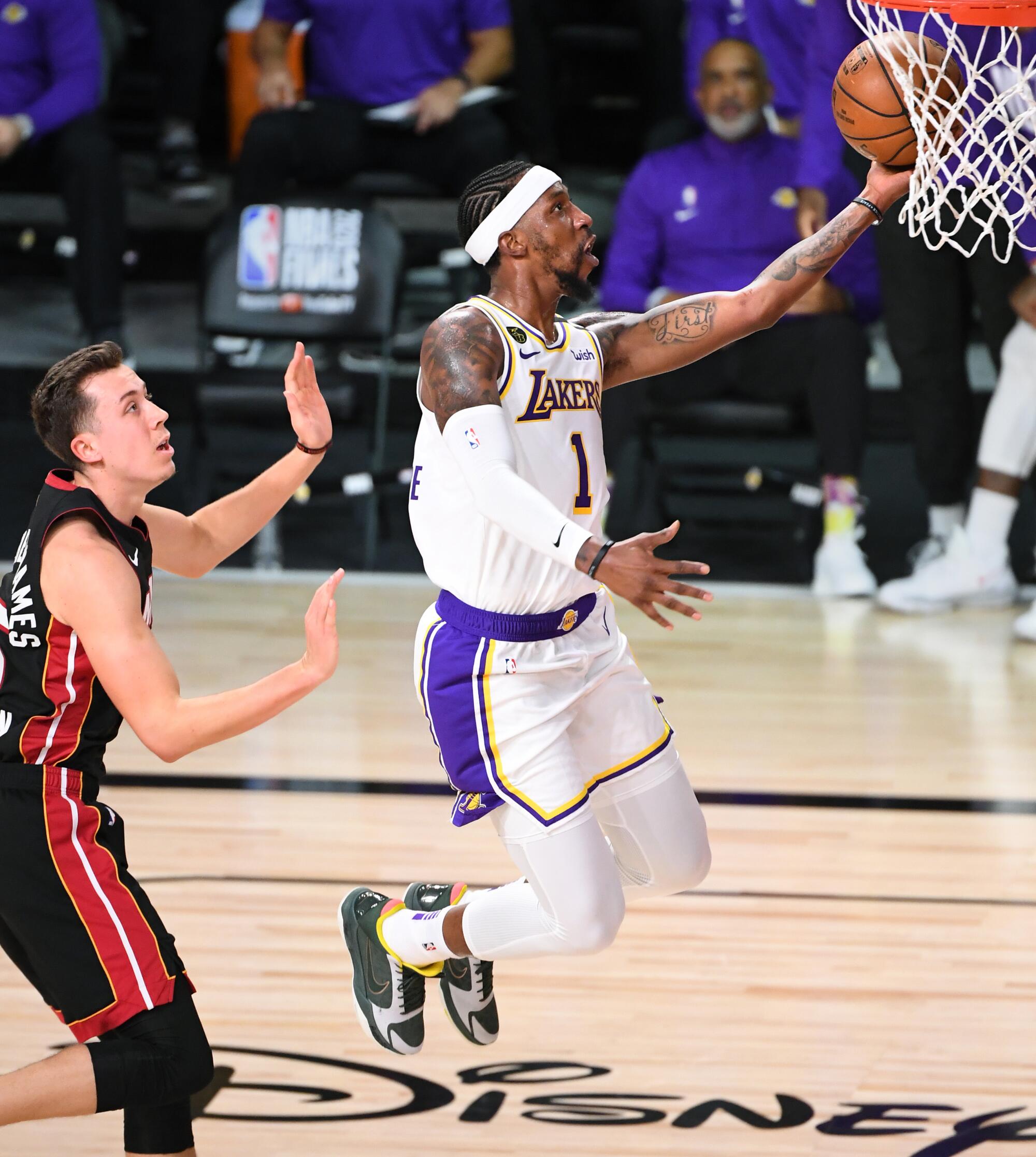
Brennan: But we can’t give ESPN all the credit. Durbin told me that this was actually part of a much broader shift in American television, particularly around basketball. And it originated with the 1979 NCAA championship matchup between who?
Maddox: Magic and Bird.
Brennan: Yes, sir.
Durbin: You look back in the ’60s and ’70s, most NBA games weren’t covered and they certainly weren’t covered on the national level. And then to any serious degree. but throughout the 1980s, and that really, I think beginning with Indiana and Michigan where you had Magic Johnson on one side and Larry Bird on the other, fighting for the college championship.
Brennan: We know what role those guys played in the Showtime era. But another thing that Professor Durbin told me about was the way that this period coincides with the explosion of cable television.
Durbin: You also had a shift that wasn’t a significant shift because it had been evolving throughout the ’80s, but a shift over more and more toward cable television. Cable television became dominant late in the ’80s.
Brennan: The rise of cable television loosens the stranglehold that football and baseball had held on television basically since the 1950s.
Durbin: From the FCC charges of the 1950s all the way up until Fox network really becomes a legitimate network by getting the NFL in 1994, you basically had three networks around the country. And that’s limited time to fill. And it was already being filled by Monday night football and in the summers by Monday night baseball.
It was hard for the NBA, the NHL and others to break into this. With the plethora of various forms of networks to appear on on cable, and with cable dominating landscape more and more and more in the 1990s, suddenly you have a moment where a basketball team can get the coverage that the San Francisco 49ers were getting in football in the 1980s.
Brennan: So by the ’90s, Durbin told me, basketball has gone from an afterthought on TV to omnipresent on TV.
Daniel Durbin: You now have cable networks to broadcast NBA basketball games. And the NBA has a much greater media presence, which opens up the possibility for the 1990s that you’re going have endless coverage of basketball available to you, if you really want it, on cable television.
Brennan: This is why I talk about it as an ecosystem, because all of these things influence each other. I don’t think anyone would say that — who saw them in person or who saw them on TV — the Showtime Lakers were not in their own ways exciting as Jordan’s Bulls. What was different was how you could distribute images of that excitement.
And it isn’t until the ‘90s, when the Bulls are the team of that day. That you get the sort of things like the “SportsCenter” top 10, where you pick out the best highlights across the world of sports every day, every telecast, which is “SportsCenter” was on, I think 24 hours a day in the ’90s, basically. You get these huge audiences for these TV moments in the ’90s, like the “Seinfeld” finale, like special episodes of “ER,” like the NBA Finals, like Tiger Woods winning the Masters.
You have this kind of perfect storm moment where the Bulls are able to take advantage of a kind of global, David Stern-refined, widely disseminated, ubiquitous TV product at the very moment where you have sort of the broadest possible audience for it. And that to me is more the reason why the Bulls become kind of like the first emblem of the NBA’s international era and not the Showtime Lakers. It didn’t have anything to do really with what was happening on the court, because as we’ve established, that’s relatively similar in basic terms. What has changed is how you watch it.
Maddox: You know, we talk about these moments that people always remember where they were, and part of it is because everyone was watching the same thing at the same time, right? Like the Magic Johnson HIV press conference, which was about basketball and Magic, but something completely different, right? It’s something that was broadcast to everyone.
And I think of, for me, I always think, I think it was their last, it was either last of their penultimate championship with the Bulls, which is — there’s this infamous play where Michael Jordan, I think he goes right and he crosses over left and he shoves the guy’s leg just a little bit. And he stumbles and he crosses over. It was the sneakiest move. It was just classic Jordan. And then he just drains this mid-range jumper, and that’s a wrap. The push is infamous. Everyone was watching that. Everyone knows where they were when Jordan pushed, did that sneaky s— and just sunk the Jazz again. He must be the most hated person in the state of Utah for what he did to that franchise.
Everyone knows about those moments. Whereas you have to kind of be in the know or a Laker fan to realize that the Magic Johnson baby hook in 1987, when Kareem had to sit out and Magic Johnson had to put the team on his back to win a championship, because we talk about that as Laker fans a lot, but it’s not the same as the Jordan push-off, which more people know about even if they’re not basketball fans.
Brennan: Right. The ’90s are the sort of peak moment of what — I think the phrase would be a national monoculture where, in the ’80s, you’re very much limited by where you live. You can see the teams in your area and an occasional sort of handful of national games, but you’re mostly limited to local fandom.
Now in the present, the audience is actually fractured by the fact that you can pretty much watch anything at any time on any platform. The NBA isn’t just competing against other sports leagues, it’s competing against video games and every movie ever made and streaming music and going on social media. You’ve had a fragmentation of the audience.
The ’90s were this sort of almost idealized moment where you have everyone able to watch and not yet distracted enough to be doing something else.
So, I think you have prepared a little something special for us to close out the season.
Maddox: I’m going to tell you all about it right after the break.
::
Maddox: Welcome back. All right, Matt. So here’s the thing: I feel like we always hear about these guys and gals, your Jerry Busses, your Kobe Bryants, your Magic Johnsons, Claire Rothmans. But it occurs to me that the Lakers — and any sports team, really — is only as strong as the people who live to watch them play. So I wanted to take a moment in our last episode to reflect on those people just a bit.
So, as you know, I come from a Laker family. Here’s my Uncle Robert explaining how that began.
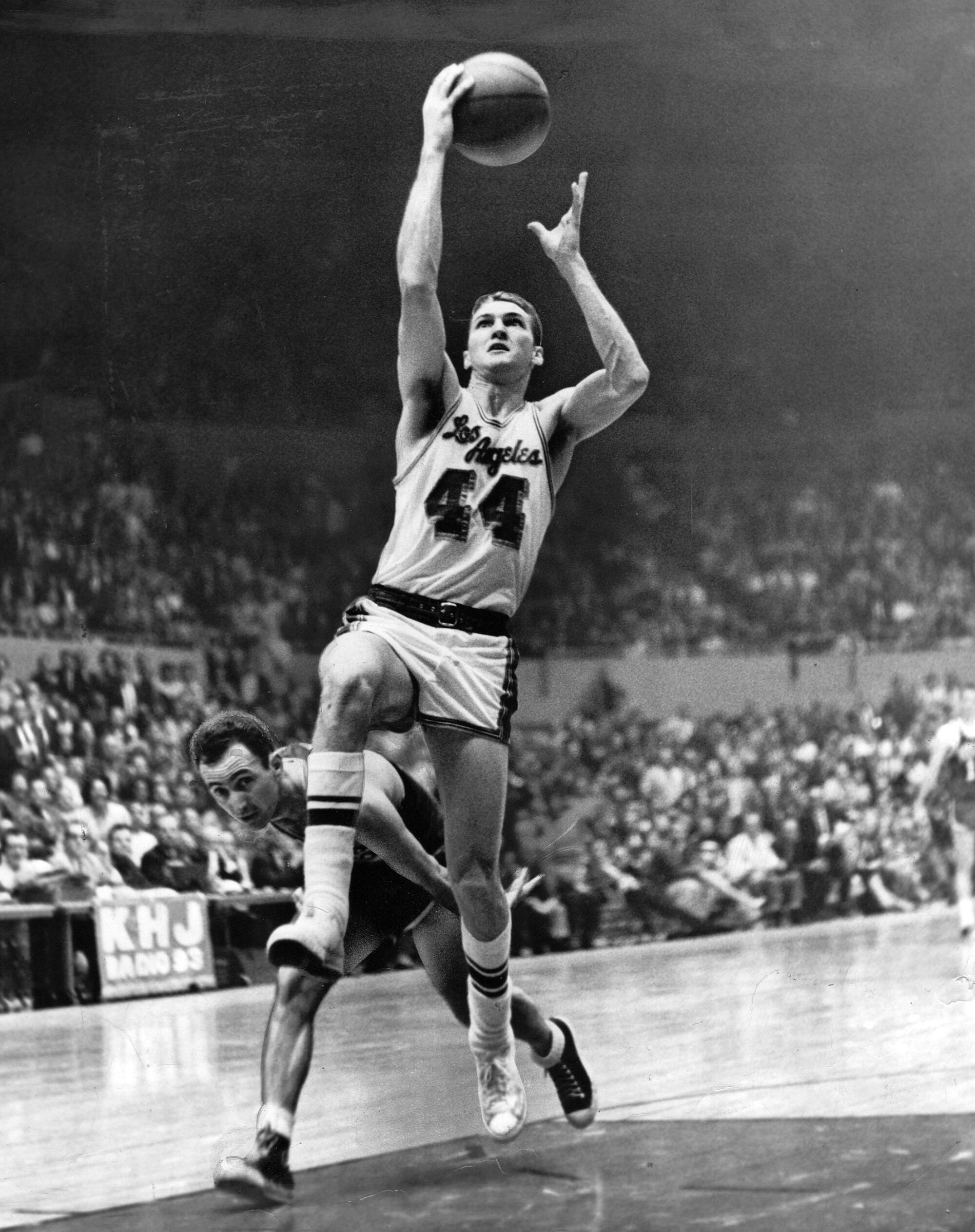
Robert Wade: My uncle Bill took me to the first ever Laker game in Los Angeles. It was an exhibition game. They played in the Sports Arena a number of years before the Forum was built. I was 14 or 16 years old. Bill was an usher; he worked for the Sports Arena. So he’s able to get us down where the players were coming out of the locker room after the game. And I could see into the door. And I noticed this young kid looking, I wouldn’t say scared, but looking kind of tentative, sitting over in the corner of the locker room. And, um, it was Jerry West, his first year in L.A. So I was bonded for life with those guys.
Maddox: That’s my Uncle Robert’s first Laker memory. He’s probably the biggest Laker fan in my family, followed by me. And after the Lakers got to L.A. in 1960, my uncle was also there for those early lean years of the Lakers losing to your Boston Celtics over and over again in the NBA Finals and even losing once to the Knicks until they finally broke through and won the NBA championship in 1972.
And that was around the time that Bill Martin’s family moved to the Southland. Bill’s an X-ray tech that I met the other week as I went to go have some X-rays done, and here’s what he had to say
Bill Martin: So when I got to California, it was the Lakers or San Diego had the Clippers. Nobody cared about the Clippers and San Diego. So it was just what it was. They came up here and rode on the coattails of the Lakers, trying to establish themselves for years.
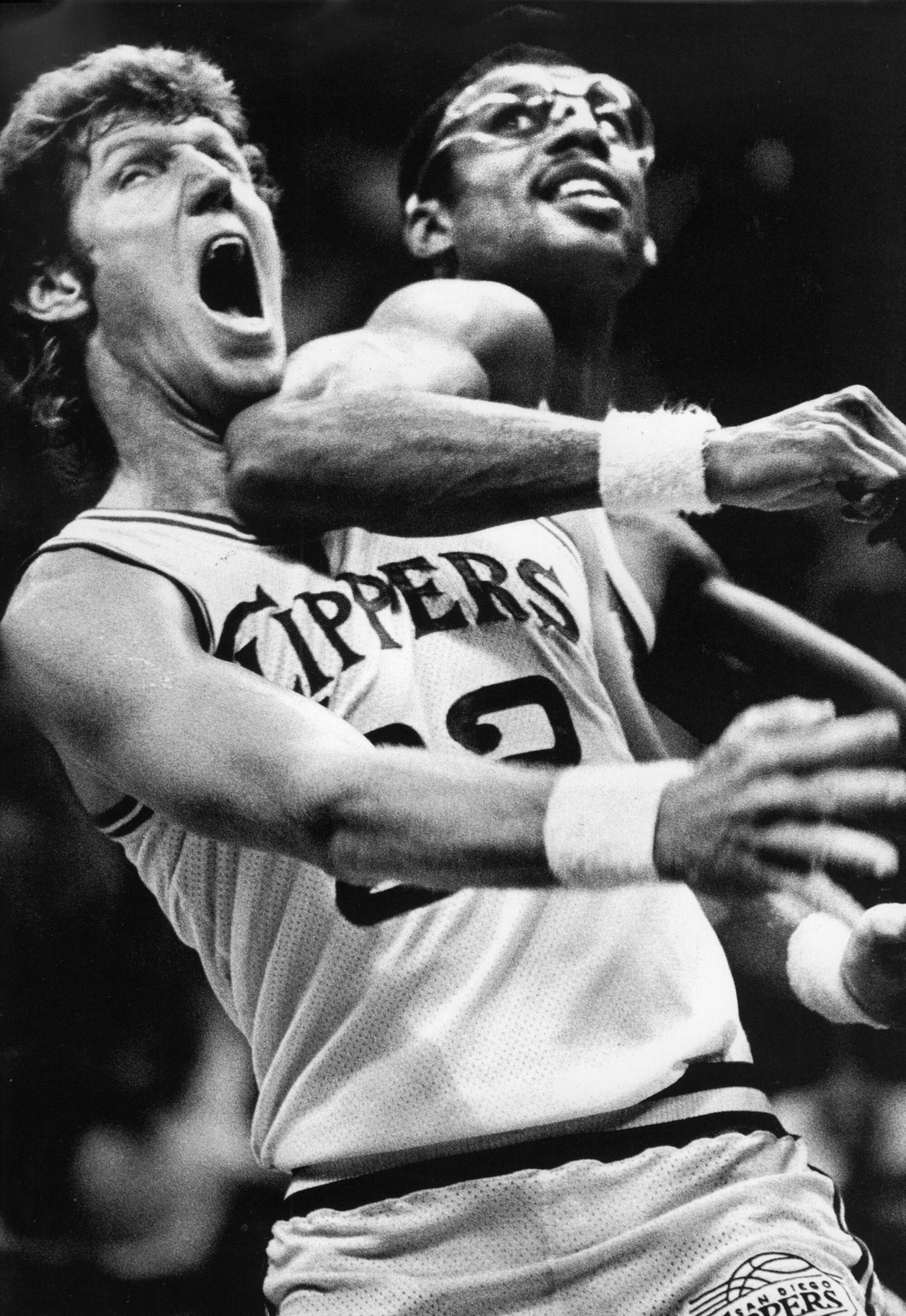
Maddox: Bill also remembers the arrival just a few years later of the Magic One.
Martin: To this day, there’s never been a point guard like Magic Johnson, never — 6-9, had blinding wizardry with the ball. Magic made passes to this day you will never see done again. Never.
Maddox: And here Bill does this thing that everyone who remembers the Showtime days does when they talk about Magic Johnson, which is: act like he has an imaginary ball and then wave his arms around wildly and then end by throwing the imaginary ball over his shoulder, behind his back. And just the joy that he gets from talking about it really speaks volumes.
Martin: I mean, come on. How’d you know this guy was behind you? You know, he’s trailing him on the break. He’s whoop whoop, whoop, whoop and boom! Magic out of the way, either Cooper, whoever, Silk, somebody coming out, Worthy. It was incredible. Incredible.
Maddox: Remember my friend Syrus from a couple of our previous episodes?
Syrus Yarbrough: I bleed purple and gold. “Oh, the Lakers suck this year. They were bad this year.” I was like, it’s only purple and gold. It doesn’t make a difference. It is what it is. It’s more than just the Lakers. It’s a lifestyle, man.
Maddox: And it’s because the Lakers mark big moments in his life.
Yarbrough: My first basketball camp ever was the Magic Johnson basketball camp. I still have the shirt. That was fifth grade. And I remember how big he was. He physically lifted three kids with one arm. I remember that. And he had a basketball in one hand in hand, the three kids I’m, like, “Who is he?” I just remember thinking he was so massive. Take little moments like that, little clips from your childhood. Magic was a really cool dude, man. His smile was always infectious. I remember thinking, “My smile, I want my smile to be like his.”
Maddox: Really? That’s a thought you had?
Yarbrough: Yes. And I smile to this day a lot because of that man.
Maddox: But you didn’t have to follow 82 games a season to feel the Lakers’ impact. Here’s our editor Lauren Raab’s dad, Mel, talking about how the team affected his life — and hers.
Mel Raab: When I first went to UCLA, Kareem Abdul-Jabbar of the Lakers was getting known for wearing goggles on court. I heard they were prescription goggles, and from his play, it looked like they did a great job for him. Years later, my beautiful daughter, Lauren, wasn’t seeing clearly from a distance. She got tested and the doctor recommended glasses.
I thought glasses might get damaged or lost, or Lauren might feel uncomfortable wearing them. The doctor said not to worry — children value their glasses, but Lauren was only 6 and her friends weren’t wearing glasses. So I was still concerned. When the glasses were ready, I told Lauren they were made just for her, which was true.
And I told her about the legendary basketball player Kareem Abdul-Jabbar.
He also had special glasses made just for him and he’d use them all the time when he was playing. He could see very well. And he helped his team win many games.
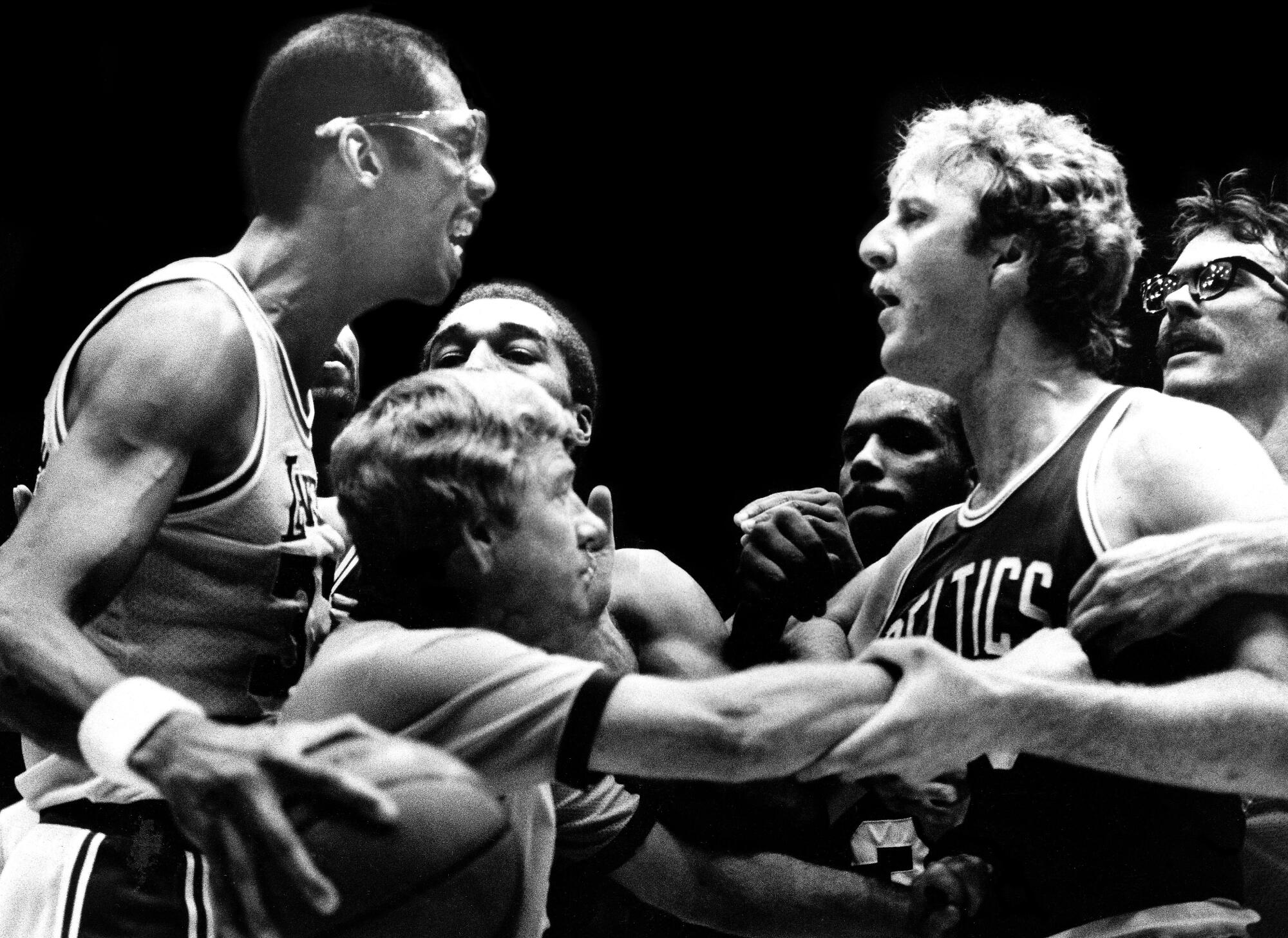
This was the encouragement Lauren needed. She proudly wore her glasses.
Maddox: And it seems like Laker fans just find each other. Like when I moved to the L.A. area at age 13 and met my best friend, who was my first friend, Eric Weiss and his parents, Ron and Mary, who you met earlier this season.
Ron Weiss: We watched every game from our living room. We would, we would be sitting there and someone would do something would be jumping up and screaming.
Ron Weiss: It was so — it was just, it, it took over everything.
Mary Weiss: I just love Magic and always felt like when Magic got the ball, all was well in the world. I mean, everything was fine. Magic would pull us out.
Ron Weiss: It was just so exciting and I miss those days, actually.
Maddox: And in the same way that Kobe kind of took the baton from the Showtime era and Magic Johnson and Kareem Abdul-Jabbar and all that, Eric took his Laker fandom from his parents and became the biggest Kobe fan in the world. And the way he talks about Laker moments is kind of the point I’m trying to make.
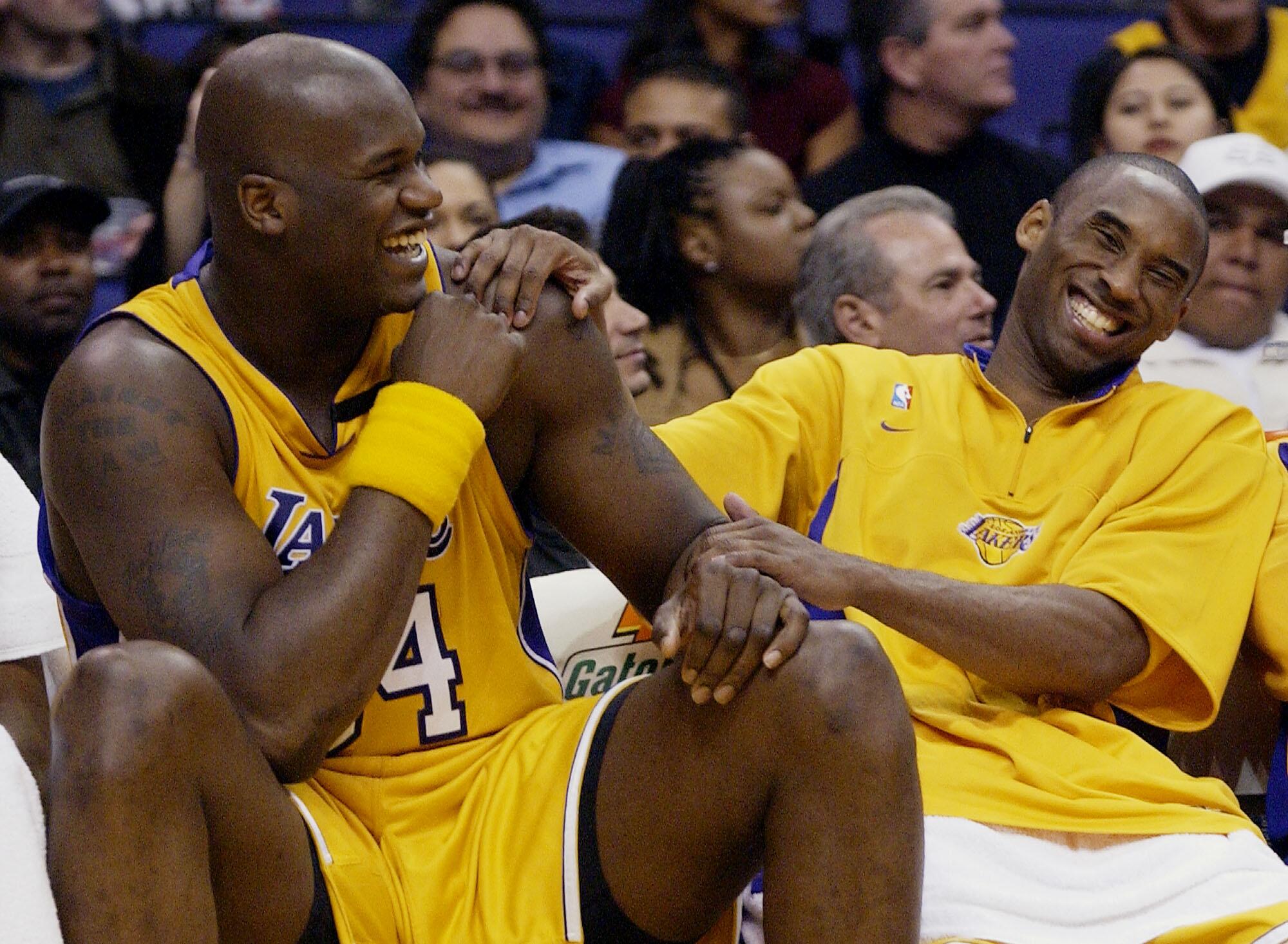
Eric Weiss: Being in a Laker family, it was always like, OK, dinner, Lakers, wake up, go to school, get home. Read the L.A. Times, Plaschke every day. It was like an institution. It was comforting, almost — putting on the Laker game. Chick Hearn. We put the radio out in the living room, muted the TV, had Chick calling the games. Just Chicky, baby. Just vintage.
Maddox: No way. So you guys would pause, you would mute the TV and put on Chick on the radio?
Eric Weiss: Mute the TV. And we had a boombox — we’re talking early ’90s to late ’90s — we had this big boombox. Sounded like crap. We had to hear Chick. It was like Chick was home. It was a comfort thing. Shaped my childhood, for sure.
Some of my best moments with my parents are, like I said, Kobe hits the shot, me and my dad hugging each other, running outside screaming top of our lungs. My mom, every game as it got close, down to the wire, she had to run upstairs and she’d have to listen to us screaming. That’s how she could tell if we were winning or not, because she was such a nervous wreck. And just those memories are just the best. I’m going to tell my kids all that. When I watch the Lakers with my kids, I’m going to be thinking about all that forever.
Maddox: None of this matters without the fans. And we’ve talked about just about everything this season: the impact these people made on the court, off the court, what they changed, what they didn’t. But those big moments in sports also mark big moments in, quote unquote, regular people’s lives that they’ll remember forever.
So naturally I have to talk about my favorite Laker memory from my life, which is summed up in three words: zero point four.
Do you know about the Derek Fisher 0.4 moment in the playoffs? No, you don’t? Do you know who Derek — do any of the words in that sentence mean anything?
Brennan: No. You might as well have described some kind of obscure NASA experiment to me. Like I have no idea what you’re even talking about.
Maddox: So this was, it was against the Spurs, and there was 0.4 seconds left on the clock, right? Which is four- tenths of a second. In basketball. When you inbound the ball, someone has to touch it. And once they touch it, the clock starts. So. It’s an impossible shot. To catch it, turn around, find the rim and release the ball in four tenths of a second.
Brennan: It’s causing me anxiety just hearing this.
Maddox: And the Lakers were sunk and we’re like, “This is never going to happen.”
Here’s another one of my best friends from high school, Josh, who I was sitting with while we were watching that play. He describes it.
Josh Schaechter: So everyone gathers around right at the free-throw line. It looks like it’s about to be a jump ball. It’s an inbound, everyone spreads out and they hit Fisher at the left elbow. And Fisher just gets it while he’s still kind of facing out of bounds to where the ball is being inbounded and he kind of lifts it in the same motion from his shoulder.
Keeps it in that same time in the same motion from being on his left shoulder. He hurtles it and almost, it’s kind of like a volleyball set, like where it comes down and goes up right away with no in-between, and he just hits it. And right when it goes in, he’s sprinting down the court like he’s doing a suicide, but he just keeps on going and he’s gone. He didn’t even want to let them watch the replays. He was like, “It’s over.”
For us, it was like a life event.
I mean, yeah, it was a life event for him too. But it’s our life too.
Maddox: And I just remember being so distraught and seeing this play happen on the projector — it actually makes me emotional right now. And, and I think that for the …. And it’s, I’m not emotional because the Lakers won. I’m emotional because my — I’ll always remember that moment, sitting with my friends in that pizza shop and seeing the impossible happen. And that’s something that sports and the Lakers give to their fans.
Brennan: There’s not really any better ending to the story that we told this season than that. ‘Cause that’s what it’s all about is the idea that sports are bigger than box scores. We wouldn’t be doing this podcast if we didn’t believe that to be true.
Maddox: Yeah. I think that’s absolutely right.
::
Maddox: Hey, sorry about that. How’s it going? What’s up? I’m rolling. Where are we starting here? Like what skills are we working with, basketball-wise?
Brennan: Like none.
Maddox: OK. Hook shot. Where do we even begin? So the reason Abdul-Jabbar was so — it was so unstoppable because imagine I’m 5 inches taller than I am. He ends the shot here. By the time Abdul-Jabbar jumps, he’s actually shooting the ball down into the hoop, which is pretty incredible. Um, there you go. I’ll try to demonstrate it.
Brennan: This is so graceful. I wish people could see this.
Maddox: So it’s like — the one foot is like, this is a fair amount of court. I had literally done this for 30 years at this point. Like I was named after him.
I should be able to hit it, shoot a hook shot.
Get it here. And then it’s like a flip. So you’re like exposing your body a little bit to the defender, meaning he can see your chest. Whereas Abdul-Jabbar, you’re getting all shoulder.
Brennan: OK. So I don’t want, like, I want like, this, and then …
Maddox: Yeah, there it is! Abdul-Jabbar started somewhere, you know?
Brennan: Yeah. He started like a foot taller than me.
Maddox: Yeah, let’s go. This is awesome, dude. That looks great. It’s not quite unblockable yet.
Brennan: I think it gives me an appreciation for — to do that at full speed in the middle of an NBA-level game, it’s like a wild amount of skill. Yeah. Like that’s the thing is, I was doing it basically in slow motion compared to how he was doing it. With no defenders.
I just, yeah. I mean, there’s a reason why it’s an iconic shot.
Maddox: And we’re going to be out here for another couple of hours until you get it right.
Brennan: [laughing]
Maddox: Have you seen “White Men Can’t Jump”?
Brennan: Yeah, for sure.
Maddox: That’s going to be me and you soon.
Everything you need to know about the true story of the Showtime Lakers, all in one place.
Additional resources
Matt Brennan, “Michael Jordan docuseries ‘The Last Dance’ is more than a TV show. It’s a cultural event,” Los Angeles Times (April 14, 2020)
Joshua Mendelsohn, “The Cap: How Larry Fleisher and David Stern Built the Modern NBA” (2020)
James Andrew Miller and Tom Shales, “Those Guys Have All the Fun: Inside the World of ESPN” (2011)
Jeff Pearlman, “Showtime: Magic, Kareem, Riley, and the Los Angeles Lakers Dynasty of the 1980s” (2013)
More to Read
The complete guide to home viewing
Get Screen Gab for everything about the TV shows and streaming movies everyone’s talking about.
You may occasionally receive promotional content from the Los Angeles Times.

